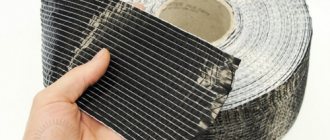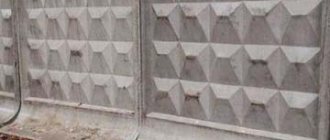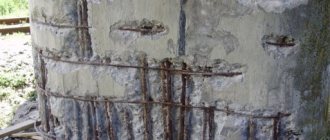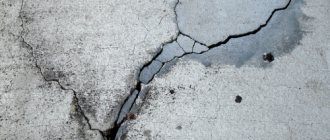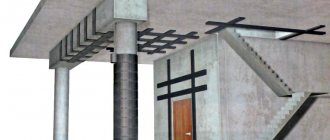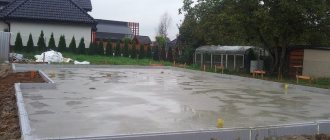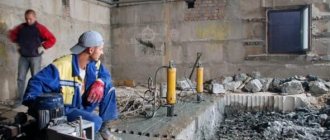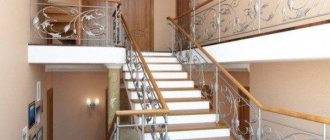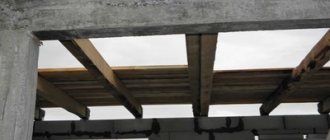Concrete structures represent a significant part of building structures, the reliability of which depends on the totality of the strength properties of the material. The durability of concrete characterizes its ability to maintain its mechanical strength throughout the entire period of operation. An objective assessment of concrete reliability factors makes it possible to exclude negative criteria, establish the causes of destruction and determine the service life of one of the main building materials.
External factors
The durability of concrete depends on the impact on its surface of a number of external factors, including humidity and precipitation, contact with aggressive organic and mineral environments, sea and groundwater, exposure to sunlight and temperature changes, the presence and magnitude of dynamic and static loads experienced. The level of destructive impact exerted depends on the chemical composition of aggressive media, the amplitude of the temperature effect, and the magnitude of the physical forces exerting a mechanical effect. Depending on the nature of its occurrence, concrete corrosion, leading to its destruction, can be electrochemical, chemical, physical, microbiological or physicochemical in nature. In most cases, there is a complex effect of external destructive factors that determine the degree of durability of the material.
Waterproof coefficient
The water resistance of concrete is its ability not to allow water under pressure to pass through it; it is inextricably linked with frost resistance. It is designated by the letter W with a coefficient from 1 to 20. To increase water resistance, sealing and water-repellent additives are introduced into concrete in factories or hydrophobic or prestressing cement is used to mix the mixture.
Concrete with a high coefficient of waterproofing allows the construction of basements in places with high groundwater levels without additional waterproofing, if the walls and floors are poured professionally without seams or interruptions. In addition, such concrete is durable - their frost resistance coefficient is high, which is ideal for unprotected structures, such as concrete paths, blind areas, fence strips, as well as for pile foundations on moisture-saturated soils. However, such concrete is not cheap due to high grades (with a high cement content); special conditions are also required to deliver and lay it on site due to the fast setting time.
Finally, once again about what can cause concrete to deteriorate:
Firstly, do not under any circumstances dilute the concrete with water when laying it. Liquid concrete is easier to lay than solid concrete, but by violating the water-cement ratio, you will thereby significantly reduce its grade and reduce its strength.
Secondly, observe all the necessary conditions for transporting concrete in a mixer, unloading time, and take into account the weather.
Thirdly, compact the mixture efficiently; voids left in the concrete due to lack of vibration when laying reduce the quality of the concrete.
Heating and cooling
One of the main destructive factors is temperature, which, as a result of cooling and heating, leads to contraction and expansion of the material. Despite the minimal coefficient of expansion of concrete, the capillary-porous structure of the building material creates the preconditions for corrosion processes that arise as a result of freezing and thawing cycles. Phase crystallization of water and salts leads to mechanical damage and volumetric changes in structure. Thermal action serves as a catalyst for the movement of heat, moisture, steam or gases within the material. Ultimately, the level of impact that heating and cooling has depends on the type of concrete, the ratio and formulation of the mixture, and the quality of the aggregates used in the manufacture. The most important criterion for the quality and durability of concrete is its frost resistance, which determines the number of permissible freezing and thawing cycles without loss of strength. In order to increase the frost resistance of concrete, special air-entraining additives are used.
Conventional concretes made on the basis of portand cements are intended for use at a temperature of no more than 200 ° C. If this value is exceeded, the material loses its strength properties due to the evaporation of crystallization moisture, leading to a breakdown of the structure. When forming refractory concrete, microfillers in the form of tuff, tripoli, fireclay and other additives are used.
Durability of reinforced concrete - theory and practice
A.B. Trinker, Doctor of Technical Sciences
In the article “Beyond the Height” (06/13/2016 ANSB news agency, Construction Business magazine), Doctor of Technical Sciences. IN AND. Travush wrote: “ In the 70s and 80s, there was practically no ” - this is an absolute historical untruth.
In the article “ Results of the 2nd International Symposium on Durability and Sustainable Development of Reinforced Concrete (DSCS-2018)” Dr. V.R. Falikman [12]: scientists from almost all countries of the world spoke at the symposium (Nanobuild.ru No. 4/2018, volume 10, pp. 162-164) - not a word was said about the author of Eternal Concrete, which does not freeze at minus 50 degrees and does not burn in fire at 1000 degrees Celsius, Eternal Concrete was first used in the world more than 55 years ago in Moscow during the construction of the Ostankino Tower.
In 1970 - 1980, the Spetszhelezobetonstroy trust of the USSR Ministry of Montazhspetsstroy, in which Ph.D. B.D. Trinker (VNIPI Teploproekt) and V.O. Gidrospetsstroy of the USSR Ministry of Energy, where engineer A.B. Trinker worked, several dozen of the tallest structures in the world were built, including: reinforced concrete cooling towers with a height of 90 to 150 meters and chimneys with a height of 250 to 420 meters at thermal power plants, state district power plants , nuclear power plants, granulation towers at chemical plants of the USSR, special structures [1-10].
In 2010, in Dubai (UAE), on the shores of the year-round and eternally warm Persian Gulf, the world's tallest skyscraper, the Khalifa Tower (Burj Khalifain Dubai, UAE), with a total height of 828 meters, was built. It was designed by an American architectural bureau and built by a South Korean company [11]. The total construction period is from 2004 to 2010. The report developed a special grade of concrete that can withstand temperatures up to +50°C. The concrete mixture was only poured at night, ice was added to the concrete mixture.", "The construction of the Burj Khalifa took 6 years to complete, using 22 million man hours. More than 30 local contractors and 12,000 workers from 100 countries were hired. The project was truly global in nature.”
We can briefly state that we found something to brag about and ask the question: “where did you get ice at 50 degrees of heat, and your “technology” is not very expensive?” It must be said: the “coldest” period is in January-February in Dubai, the temperature is constant and never drops below plus 16-20 degrees.
The use of even the latest “achievements” of the 21st century in construction (superplasticizers of the “next” invented generation, ice in the concrete mixture, concreting only at night and only 2 times a week) and logistics (mixers, concrete pumps) did not guarantee the pace (timing) of construction and quality concrete.
Domestic builders have 70 years of significantly richer and more versatile experience in carrying out work in hot and dry climates, with solar radiation and stormy winds, in a truly catastrophic (!) climate. The selection of materials, design and selection of compositions of any concrete for any climate in the World, that is, from minus 50 degrees (for example in Yakutsk) to plus 55 degrees Celsius and at any humidity, has been carried out by construction laboratories for 60 years in accordance with the universal “Guide to design and selection of compositions of hydraulic and ordinary concrete" 1957, developed by the Scientist Ph.D. B.D. Trinker (photo 1):
Photo 1 B.D. Trinker was born in 1914, defended his diploma with DISTINCT at the Moscow Art University named after D.I. Mendeleev in 1939, entered the Graduate School, was drafted to the front in November 1939, fought on the Karelian and 3rd Ukrainian fronts, in December 1945 demobilized, in 1955 he defended his only dissertation, in 1963-1967 he built the very first structure in human history above 500 meters made of reinforced concrete in Ostankino. Photo from 1945: B.D. Trinker, captain of a company commander in forever liberated Vienna.
The documents developed by B.D. Trinker have the most important principles: simplicity, accessibility, accelerated methodology for all calculations in 1-2 days (!), absence of complex formulas, accuracy and planning of results, that is, designed super-strong and super-durable Concrete . The theoretical developments of this “Manual” were made and practically confirmed during the preparation and construction of the first high-rise structures made of reinforced concrete (photo 2), exposed to acid attack and the influence of a significant gradient of alternating temperatures.
Photo 2 Construction of the first high-rise chimneys made of reinforced concrete at thermal power plants and state district power plants, head of the laboratory of high-rise and special structures of the USSR Ministry of Montazhspetsstroy Ph.D. B.D. Trinker at his Height, 1957.
By definition, a hot and dry climate: with temperatures “above plus 25 degrees Celsius and relative humidity less than 50%” - this requires many special additional measures in technology.
In the UAE, the climate is hot, maritime but not dry, the temperature reaches 50 degrees, but the relative humidity is within 90%, which does not contribute to the rapid drying of hardening concrete!
On the contrary: in Kazakhstan’s Ekibastuz, in addition to the high temperature of plus 55 degrees in the shade, at the same time the relative air humidity is 25%, which, like a pump, pulls all the moisture out of the hardening concrete. In such a catastrophic climate, hardening concrete crumbles to dust without protection.
In the period from 1977 to 1979 in Kazakhstan, at Ekibastuz State District Power Plant No. 1 (with a capacity of 4 million kW), the author of the article built the first highest-rise engineering structures in Asia, chimneys 300 and 330 meters high, made of reinforced concrete with design grades M400 (class B30 ), F300 and W8 (photo 3). Main parameters of the pipe: outer diameter at the base = 32 meters, outer diameter of the upper section = 12 meters, wall thickness varies from 0.8 m at the base to 0.3 m at the top. The calculated high seismicity = 9 points forced the use of reinforced periodic profile reinforcement with a diameter of 38 mm, which led to the need to use a cast mixture with a mobility of 24-26 cm of settlement of a standard cone. It should be noted: the only engineer from the entire science of the USSR who worked in construction was the USSR Ministry of Energy engineer A.B. Trinker, who built a powerful BSU that supplied all objects with high-quality concrete.
Photo 3 Ekibastuz State District Power Plant No. 1 was built in 1977-1979 in the sharply continental and catastrophic climate of Kazakhstan at a summer temperature of plus 55 degrees Celsius and a relative humidity of about 25%, in winter at minus 40 degrees Celsius, chimneys with a height of 300 and 330 meters. Author of the project and technology Ph.D. B.D. Trinker, author of BSU and Concrete engineer A.B. Trinker.
In 1979-1980, a 330-meter chimney was erected at the Kirishi State District Power Plant using the LTM superplasticizer, a concrete pump, and sliding formwork, with record sliding speeds in winter conditions of 3-5 meters per day.
Since 1976, using a new conveyor technology, they began to build monolithic, thin-walled, extra-durable reinforced concrete cooling towers with a height of 90 meters without working concreting joints at a thermal power plant with a Superplasticizer LTM (TU-480-2-4) from a cast concrete mixture (24-26 cm. O.K. ) in sliding formwork using a concrete pump, designed for 100 years of operation in extreme, all-weather temperature and humidity conditions, at temperatures: inside water condensation plus 40-60 degrees, outside in weather from minus 50 to plus 50 degrees Celsius (photo 4, 5 ).
Photo 4 Unique monolithic seamless structure, cooling tower at Mosenergo CHPP-25, 1977.
Photo 5. Chief builder engineer of the USSR Ministry of Energy Alexander Trinker (right) and director of the Mosenergo CHPP-25 under construction in Ochakovo, 1977.
Project and technology: Ph.D. B.D. Trinker (1914 – 2004) head of the laboratory of high-rise and special structures at VNIPI Teploproekt of the USSR Ministry of Montazhspetsstroy.
Construction: from 1976 to 1983, working in V.O. "Gidrospetsstroy" of the USSR Ministry of Energy, engineer A.B. Trinker built standard 90-meter cooling towers at Moscow CHPPs - 20, - 21, - 22, - 23, - 25, - 26, in Leningrad (Northern and Southern CHPPs), Minsk and Gomel (Belarus), Kiev CHPP-6 (Ukraine), etc., the speed of construction of cooling tower shells ranged from 3 to 6 meters per day, in contrast to the previous technology in adjustable formwork = 1 meter in 2 days under favorable conditions .
— In 1981, for the conveyor high-speed technology of constructing 90-meter cooling towers at thermal power plants (reliable supply of electricity to the country), the Prize of the Council of Ministers of the USSR was awarded, the headline in the newspaper: “for particularly outstanding projects and construction,” 19 opportunists received an unearned gold medal and 650 rubles each.
— In 1987, for the technology of modifying lignosulfonates LTM according to TU-2-4-86 and the successful use of millions of cubic meters of durable and high-strength concrete, the Prize of the Council of Ministers of the USSR was awarded to 20 opportunists. The real scientists who created and applied the technology did not receive a prize!
In 1985, at Ekibastuz State District Power Plant No. 2, the world’s tallest chimney with a height of 420 meters was built (photo 6), a participant in the international “Guinness world records”. The diameter of the pipe at the base is 44 meters, at 420 m = 14.2 meters, 35,000 m3 of concrete. It was a unique structure of the 20th century, using new technology, made of new generation concrete, with simultaneous (!) installation of outer and inner shafts, an inner shaft made of lightweight concrete with the polymer additive ACF, which reliably withstands acid corrosion of condensate from flue gases. Technology development and project Ph.D. B.D. Trinker.
Photo 6. The world's tallest reinforced concrete chimney, erected at Ekibastuz State District Power Plant No. 2 in 1985, 420 meters. Member of Guinness world records. The author of the project and new technology is Ph.D. B.D. Trinker, author of Concrete and designer of the BSU in Ekibastuz, engineer. A.B. Trinker.
Comparing with the “Khalifa Tower”, each chimney was built by the general contractor trust Ekibastuzenergostroy Ministry of Energy of the USSR (owner of the BSU and warehouse facilities) and the subcontractor, pipe No. 1 V.O. "Gidrospetsstroy" of the USSR Ministry of Energy, and pipe No. 2 trust "Spetszhelezobetonstroy" of the USSR Ministry of Montazhspetsstroy. The teams had 200 workers on each pipe, the construction of each pipe took about two years, with pipe No. 1 followed by the installation of a second internal shaft from silicon concrete panels, pipe No. 2 with simultaneous concreting of the inner shaft.
Unlike residential skyscrapers built in the 21st century (photo 7), chimneys must operate for a long time and without repair in highly aggressive environments: condensates of various acids released from fuel combustion products at thermal power plants and state district power plants. The concrete of chimneys must additionally be corrosion-resistant in highly aggressive acidic environments, that is, incomparable to the service conditions of any skyscrapers in residential cities, which are subject to only light atmospheric corrosion.
Photo 7. The tallest skyscrapers in cities, in first place is the Burj Khalifa, built in Dubai (UAE) in 2010 in a warm climate favorable for concreting, with a height of 828 meters.
The sharply continental climate of Kazakhstan has shown serious problems in science and construction. Temperatures in the winter reached minus 40 degrees Celsius with stormy winds from which tower cranes and walls of the main building fell; in the summer months the air temperature reached 55 degrees in the shade, with a relative humidity of 25% (and in Dubai-UAE = 90%!) . Moreover, within one day, air fluctuations reached 30-40 degrees Celsius. For example: in July 1978, at 7:00 am, when production crews were leaving on buses from the city hostel to the construction site, the air temperature was 15-20 degrees, at 12:00 pm the temperature reached 40 degrees, at 3:00 pm the temperature reached 55 degrees, then a slow decline began, and when the teams returned to the city at 20-00 (12-hour shifts), the temperature was 30-35 degrees, and at night the air “cooled” to 15-20 degrees Celsius.
In a hot and dry climate, hardening concrete is exposed to the following harmful effects: solar radiation and wind force the evaporation of moisture from the concrete of structures with a large open surface, this leads to internal mass and heat transfer, and to variable thermal stresses in their walls. The need to obtain high mobility of cast concrete mixtures increases the consumption of cement, which causes shrinkage when heating from solar radiation varies along the perimeter of the structure. Cracks in the concrete of structures arise under the influence of shrinkage, from temperature and shrinkage stresses that arise in concrete during the process of heat and mass exchange with the environment.
Intense evaporation of moisture reduces the degree of hydration of cement and leads to the formation of directed capillaries, which worsen the micro- and macrostructure of cement stone and concrete; the quality of concrete, its density, strength, and durability sharply decrease. The formation of cracks and deterioration of the structure of concrete under the influence of variable solar radiation around the perimeter of the structure lead to irreversible changes in concrete. Therefore, it is necessary to ensure a reduction in the magnitude and intensity of moisture evaporation from concrete and to create all the required conditions for complete hydration of cement and the formation of an optimal structure of cement stone and concrete, thanks to the equalization of humidity and temperature gradients across the cross-section of the walls of the structure. This is achieved by moisture protection and thermal protection of concrete, helping to equalize the temperature along the cross-section and perimeter of the structure.
Concreting of the chimneys of Ekibastuz State District Power Plants took place continuously and around the clock, chimney No. 1 at Ekibastuz State District Power Plant was erected in sliding formwork, chimney No. 2 at EkGRES No. 1 was erected in a sliding form. It was practically proven: even in the most severe climatic conditions at a temperature of plus 55 degrees and a relative humidity of 25%, the rate of rise of the sliding formwork reached 3-4 meters per day, and the rate of rise in the adjustable formwork (pipe No. 2, EkGRES No. 1) was only only 1 meter per day. The most reliable, simple, safe to use and successfully used since 1947 surfactant - SDB was introduced into the concrete mixtures, which guaranteed the production of a cast (24-26 cm) concrete mixture and at the same time the highest design grades of concrete in the building: M400 (class B30) , F300, W8. Laboratory quality control (now called “monitoring”) of the production of concrete mixture at the batching plant, during laying in formwork, and subsequent maintenance was immediately organized around the clock.
The use of sliding formwork for a unique structure was carried out in the USSR for the first time, in order to accelerate the pace and quality, taking into account that with sliding formwork for a structure 330 meters high, there will be 330 working joints in which the concrete is more permeable, and the entire structure is non-monolithic. However, the haste of the top management and the categorical demand to start on April 12, 1978 without a supply of building materials of the required quality could lead to an accident, the author of the article was forced to overestimate the grade of the designed concrete, and in addition, the construction department of SSMU Energovysotspetsstroy was unable to establish continuous and constant geodetic control with PZL devices — as a result, at a rate of formwork lifting of 3-4 meters per day, deviations from the vertical of up to 600 mm occurred. A control test with ultrasonic devices showed the concrete strength was higher than the design one (M450 - M500) and only for this reason the TEP designers agreed on the final height of pipe No. 1 = 300 meters, that is, the overestimation of the design grade of concrete by the author saved the chimney No. 1 of EkGRES No. 1 in 1979.
It should be noted: all high-altitude workers during the construction period were provided with housing, high-altitude allowances and travel allowances were added to salaries (basic tariff), in Ekibastuz there was no end to those interested, in addition there was a coefficient of 1.3 for difficult conditions, in As a result, the average worker’s monthly salary reached 2,000 rubles (with the salary of the average engineer in the country being 150 rubles/month).
Ekibastuz State District Power Plants No. 1 and No. 2 have been operating continuously and trouble-free (!) for more than 40 years, producing electrical energy for the whole of Kazakhstan, which proves the high durability of concrete and the reliability of chimneys erected by Soviet builders. Moreover, there are additional capacities, since power plants do not operate at full load; therefore, if necessary, for new electricity consumers in Kazakhstan or outside the country, it can be increased by connecting backup boilers.
Construction experience in Kazakhstan under critical parameters: temperature plus 55 degrees and relative air humidity of 25% indicates the need for strict compliance with all requirements for preparation, preparation of concrete mixture and care of hardening concrete, geodetic control, which ensured high durability of structures.
As a result of the use of the simplest and most reliable only domestic technologies of concrete and building materials, a huge economic effect was obtained, and it should be taken into account: high-rise reinforced concrete structures erected by Soviet engineers were never painted (with the exception of marking signal painting for aircraft), and all skyscrapers in the world are protected stainless metal, glass and silicone; old metal structures, for example the Eiffel Tower, are periodically painted every 7-9 years. It is necessary to note: the so-called “hydrophobization” using GKZh (Dr. Technical Sciences F.M. Ivanov and Doctor of Technical Sciences V.G. Batrakov, NIIZHB) practically DOES NOT protect concrete, as it is washed off by the first rain.
The most reliable protection of Concrete is the use of PRIMARY PROTECTION AGAINST CORROSION according to the theory and methods of the Scientist Ph.D. B.D. Trinker.
The experience of constructing the tallest reinforced concrete structures in Asia at Ekibastuz State District Power Plant No. 1 in 1977-1980, and the tallest chimney in the World at Ekibastuz State District Power Plant No. 2 in 1985, instructions and documents developed by B.D. Trinker were successfully applied in the 21st century during the construction of skyscrapers, however, one must understand that despite all the powerful Western advertising and propaganda, it is a fact: all skyscrapers are lined with metal-glass-silicone, that is, they protect the concrete core of rigidity, the Eiffel Tower is painted with PAINT, and the concrete of all our buildings, including the Ostankino Tsar Tower never protected or painted!
Conclusion :
For the creation of a unique all-weather, super-strong, super-durable ETERNAL Concrete, for the elimination of Corrosion, for the prevention and absence of man-made disasters, armchair theorists received state awards several times, but without the Main Author himself: Ph.D. B.D. Trinker, and in connection with the liquidation of VNIIGPE and the creation of FIPS and other “perestroikas” - the name of the Author was deleted from the list of “cited” scientists of the twentieth century.
Examples:
1. “From the Commission for Prizes of the Council of Ministers of the USSR for the most outstanding projects and construction of reinforced concrete cooling towers in sliding formwork” dated May 31, 1981, list No. 3, 19 associated thieves' recipients, without the most Main Authors of Theory and Practical Application: the surname Trinker is missing .
2. Award of the USSR Council of Ministers Prize, 1987: “for the development and application of modified LTM Lignosulfonates”, 20 thieves who joined, without the most important AUTHORS of Theory and Practical Application - the name Trinker is missing.
3. award of the USSR State Prize in 1984: No. 24 in the field of technology “for the development of the theory of corrosion of concrete and reinforced concrete and the creation on its basis of durable reinforced concrete structures for mass construction” - a list of 9 armchair “theorists”, but without the most important Author.
Bibliography:
1. Patent No. 87043: Method for preparing plastiment for concrete and catalyst for grinding cement clinker; stated 12/24/1948, published 01/01/1950: B.D. Trinker. “The subject of the invention is a method for preparing plastiment used as a plasticizer for concrete or as a catalyst for grinding cement clinker.”
2. Trinker, B. D. From the experience of production and use of plastic slag cement, Ministry of Construction of Mechanical Engineering Enterprises of the USSR, Technical Directorate of the Construction Research Institute, Dept. tech. Information, Moscow, Mashstroyizdat, 1950, 10 pp.
3. Trinker, B. D.; Stolnikov, V.V. Instructions for the production of concrete using plasticized cement or ordinary cement with the addition of sulfite-alcohol stillage concentrates on site, (IM-202-51), approved 10/17/1951, State Committee of the USSR Council of Ministers for Construction Affairs, Moscow, 1951, 18 pp.
4. Trinker, B. D. Application of plasticized cement and plasticizing additives to concrete, Ministry of Construction of Mechanical Engineering Enterprises of the USSR, Technical Directorate, Scientific Research Institute for Construction, Moscow Leningrad: State. publishing house of literature on construction and architecture, 1952, 64 pp.
5. Trinker B.D. Increasing the durability of hydraulic concrete with additives from Sulfite-Alcohol Stillage SSB, “Conference on concrete corrosion and measures to combat it,” March 17-20, 1953, Moscow, Volkhonka, 14.
6. Trinker, B. D. The influence of surfactants and electrolytes on the hardening processes and frost resistance of concrete Abstract of thesis, presented. for the scientific competition. candidate of technical degrees Sciences, Institute of Higher Education education of the USSR. Moscow Order of Lenin chemistry-technol. Institute named after D.I. Mendeleev, Moscow, 1955, 20 pp.
7. Trinker, B. D. “Guide to the design and selection of the composition of hydraulic and conventional concrete”, Ministry of Construction of the RSFSR, Moscow, 1957, 54 pp.
8. Trinker A.B. “Experience in the production of concrete works during the construction of special high-rise structures in dry and hot climates,” magazine “Special Construction Works,” No. 11, 1979, pp. 3 – 9.
9. Trinker A.B. “Unified system for high-speed concreting of high-rise structures”, magazine “Concrete and Reinforced Concrete”, No. 12, 1983, pp. 20 – 21.
10. Trinker A.B. MY FATHER’S TOWER, Rossiyskaya Gazeta, Rodina project, January 11, 2022.
11. CTL Group. “Burj Khalifa, the Tallest Building in the World.” Last modified 2011. Accessed Nov. 15, 2011.
12. Falikman V.R. Results of the 2nd International Symposium on Durability and Sustainable Development of Reinforced Concrete (DSCS-2018), Nanobuild.ru No. 4/2018, volume 10, pp. 162-164.
Bibliography:
1.Patent No. 87043: A way of preparation of the plastiment for concrete and the catalyst for grind of cement clinker; it is stated 12/24/1948, published 1/1/1950: BD Trinker. "A subject of an invention is the way of preparation of the plastiment applied as softener to concrete or as the catalyst to grind of cement clinker."
2. Trinker, BD From experience of production and use of plastic slag cement, the Ministry of construction of the enterprises of mechanical engineering of the USSR, Technical management of scientific research institute of construction, Otd. tech. Information, Moscow, Mashstroyizdat, 1950, 10 p.
3. Trinker, B. D.; Stewards, VV The instruction for production of concrete with use of the plasticized cement or usual cement with additive on the place of works of concentrates sulphitic and alcohol bards, (IM-202-51), is approved 10/17/1951, the State committee of Council of ministers of the USSR for construction, Moscow, 1951, 18 p.
4. Trinker, BD Use of the plasticized cement and the plasticizing additives to concrete, the Ministry of construction of the enterprises of mechanical engineering of the USSR, Technical management, Research institute of construction, Moscow Leningrad: State. publishing house of literature on construction and architecture, 1952, 64 p.
5. Trinker BD Increase in durability of hydrotechnical concrete additives from Sulphitic and Alcohol Bards of CoB, “A conference on corrosion of concrete and measures of fight against it”, on March 17-20, 1953, Moscow, Volhonka, 14.
6. Trinker, BD Influence the poverkhnostnoaktivnykh of substances and electrolytes on processes of curing and frost resistance of concrete the Abstract a yew., rep. on a competition Wuchang. candidate's degrees technical Sciences, M-in tertiary formations of the USSR. Mosk. the Orders of Lenin chemical - technol. in-t of DI Mendeleyev, Moscow, 1955, 20 p.
7. Trinker, BD “Guide to design and selection of composition of hydrotechnical and usual concrete”, Ministry of construction of RSFSR, Moscow, 1957, 54 p.
8. Trinker AB “Experience of production of concrete works at construction of special high-rise constructions in conditions of arid and hot climate”, magazine “Special construction works”, No. 11, 1979, p. 3 - 9.
9. Trinker AB “Uniform system of high-speed concreting high-rise constructions”, Beton I Zhelezobeton magazine, No. 12, 1983, p. 20 - 21.
10. Trinker AB Tower of my FATHER, Rossiyskaya Gazeta, project Homeland, on January 11, 2022.
11. CTL Group. "Burj Khalifa, Tallest Building in the World." Last modified 2011. Accessed Nov. 15, 2011.
12. Falikman VR Results of the 2nd international symposium on durability and sustainable development of reinforced concrete (DSCS-2018), Nanobuild.ru No. 4/2018, volume.10, p. 162-164.
Durability of reinforced concrete - the theory and practice
ABTrinker, Dr.Sci.Tech.
Abstract: in 2010 in the UAE the highest building in the world was built, and in 1979 in Kazakhstan domestic builders constructed the highest construction in Asia, in the same roast, but sharp and continental climate with very cold winter. Huge difference: at constant climate and humidity of 90% in the UAE ; in Ekibastuz humidity of 25% with a temperature in the summer of 55 degrees, in the winter minus 40 degrees, but we built continuously and round the clock, and in the UAE built 2 times a week only at night and only. The only advantage at builders in XX1 is a century excellent communication.
Keywords: great inventors of the XX century, catastrophic climate, all-weather durable concrete, rates and quality
08/31/2018. AT
Mechanical influences
When designing concrete products, load-bearing and other structures, their massiveness and volume depend on the load that the material will experience during its entire service life. Mechanical loads are divided into static, the nature of which implies constant impact, and dynamic, which arise in the form of short-term acting forces of varying amplitude. The presence of dynamic shocks causes shrinkage deformations, which manifest themselves over time in the presence of significant loads. The hardness characteristics of concrete directly depend on the brand of cement used.
Over time, abrasion and wear cause the integrity of concrete surfaces to deteriorate. Overloads contribute to the appearance of internal stress in structures, which reduces their durability.
State standards for the preparation of concrete compositions
After the appearance in GOST 26633-91 of paragraph 1.6.2 on the possibility of using compositions with quality indicators that are below the GOST requirements (after conducting research in specialized centers), the quality indicators of concrete structures began to decline. The state standard does not clearly state the requirements for conducting such research. Therefore, in order for the structures being built to have a long service life, special attention should be paid to the presence of impurities in the aggregates. To create frost-resistant concrete, it is advisable to use cements with an alkali content not exceeding 0.6%. You should also make sure that it is necessary to use cements containing belite, which are recommended for use in the construction of massive structures, as well as objects in hot climates.
An unbalanced content of gypsum and alkalis provokes rapid setting, resulting in the appearance of “quickies”. The higher the belite content in the cement, the more important the S03 percentage.
Contact with water
For a long period, many concrete products and structures are operated in contact with the aquatic environment. In this case, moisture can be groundwater, wastewater, river water, or sea water. Seasonal precipitation in the form of rain and snow is also one of the factors affecting concrete. For reinforced concrete products, the strength of which is enhanced by a reinforcement cage, contact with water can lead to corrosion of the metal rods. The water resistance of a material depends on the number of available macropores in the open state, which appear during the evaporation of excess liquid, as well as the presence of technological cracks. To reduce the level of impact of concrete, special additives are used and vibration casting technology is used, which allows the porosity of the material and its permeability to be minimized.
Concrete grade (M)
In all information materials, price lists, etc. concrete is indicated with a digital and letter index. Brand M-, class B-, mobility P-, water resistance W-, frost resistance F- must be indicated
Your project determines the choice of a specific type and grade of concrete. If there is no project, then you can listen to the advice of builders or figure it out yourself.
The numbers for the concrete grade indicate the average compressive strength in kgf/sq.cm. Compliance with the declared brand of concrete is checked by casting a mixture of cubes or cylinders from a sample and allowing them to harden for 28 days.
Currently, such a characteristic of concrete as a class is used - this is approximately the same as a grade, but with the only difference that the grades indicate the average value of strength, and the grades indicate strength with guaranteed security with a coefficient of variation of 13%. In accordance with ST SEV 1460, all modern design requirements are indicated in classes, although most construction companies use a brand for ordering.
It is important for you that the brand of concrete matches the one you ordered. How to check? To do this, you need to take a sample and cast from it several cubes measuring 10X10X10 cm or 15X15X15 cm. It is most convenient to use the necessary forms knocked together from planks, having previously moistened them so that they do not absorb the water included in the concrete and do not interfere with hydration. For the purity of the experiment, it is necessary to pierce the poured mixture so that there are no air voids left. You can also compact the mixture by hitting the sides of the mold with a hammer. Samples should be taken directly from the concrete carrier tray, do not dilute the mixture in a concrete mixer truck, thoroughly compact the mixture in the molds and store at medium temperature (about 20 C) and high humidity.
After 28 days, any independent laboratory can check the compliance of the brand of your concrete with the declared one.
There are also intermediate stages of hardening - 3, 7, 14 days. During the first seven days, concrete gains 70% of its strength. There are also other methods for determining strength - these are the so-called indestructible “on-site” measurement methods. These include the shock pulse method (“tapping the concrete”), ultrasonic methods and others. Concrete class
| Average strength of concrete of this class, kgf/sq.cm | Nearest brand of concrete | |
| В3.5 В5 В7.5 В10 В12.5 В15 В20 В25 В30 В35 В40 В45 В50 В55 В60 | 46 65 98 131 164 196 262 327 393 458 524 589 655 720 786 | M50 M75 M100 M150 M150 M200 M250 M350 M400 M450 M550 M600 M600 M700 M800 |
Chemical factors
Chemical corrosion of concrete is observed as a result of the action of organic compounds, solutions of salts, alkalis, acids and their oxides in liquid and gaseous states. The dynamics of destructive processes depend on the degree of aggressiveness of the acting environment and the mineralogical composition of the building material. The rate of destruction is a function of the level of solubility of the concrete surface, namely its constituent parts, during the reaction with the solution. An effective method for extending the service life of concrete when there is a danger of chemical corrosion is waterproofing, which is formed in the form of an external coating based on special materials that do not react with an aggressive environment.
Actual durability
The experience of using structures of these types has a long history. The most ancient object in the construction of which lightweight concrete was used is considered to be the “temple of all gods” Pantheon, which is over 2000 years old. Despite the fact that the declared service life of reinforced concrete structures is only 150 years, there are structures of a similar age that are well preserved to this day.
To calculate the durability of concrete and reinforced concrete, special VNII formulas are used today, according to which, at the lowest level, the indicator is 5 years, at the highest - 269 years.
How long can you keep concrete in a mixer?
Transportation of concrete
The mixture must maintain its temperature and mobility.
The duration of transportation of ready-mixed concrete
at a temperature of 25°C should not exceed half an hour to an hour, and at 30°C - 15...25 minutes.
Interesting materials:
How to determine the volume of a pallet? How to identify alder? How to determine orthophosphoric acid? How to determine acute or obtuse angle? How to determine relative air humidity in geography? How to determine relative humidity? How to determine the parameters of an LED strip? How to define a lavalier microphone? How to identify wood defects? How to determine the right and left sink?
